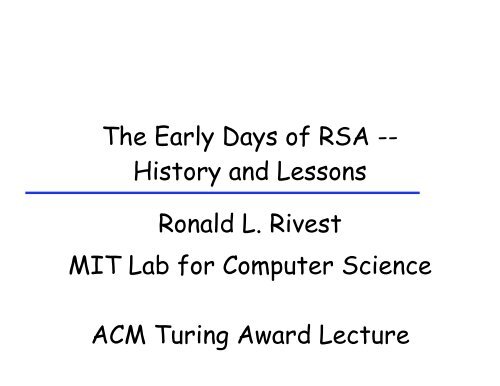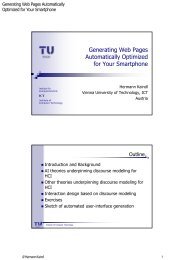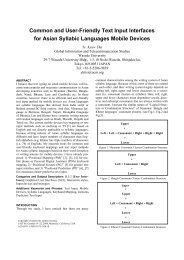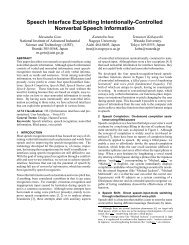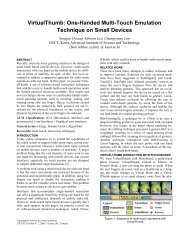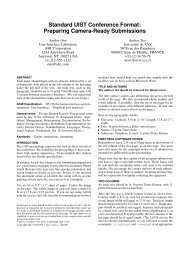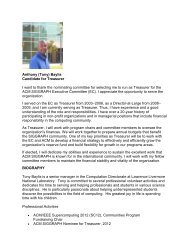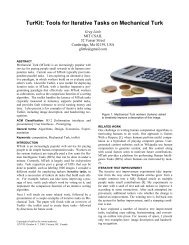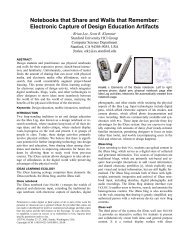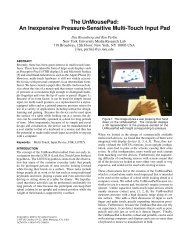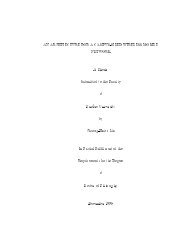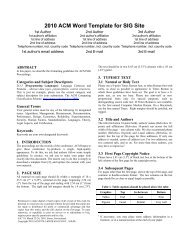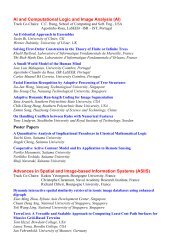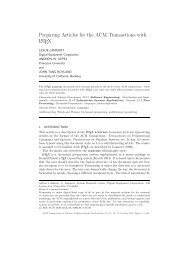The Early Days of RSA -- History and Lessons Ronald L. Rivest MIT ...
The Early Days of RSA -- History and Lessons Ronald L. Rivest MIT ...
The Early Days of RSA -- History and Lessons Ronald L. Rivest MIT ...
Create successful ePaper yourself
Turn your PDF publications into a flip-book with our unique Google optimized e-Paper software.
<strong>The</strong> <strong>Early</strong> <strong>Days</strong> <strong>of</strong> <strong>RSA</strong> --<br />
<strong>History</strong> <strong>and</strong> <strong>Lessons</strong><br />
<strong>Ronald</strong> L. <strong>Rivest</strong><br />
<strong>MIT</strong> Lab for Computer Science<br />
ACM Turing Award Lecture
<strong>Lessons</strong> Learned<br />
u Try to solve “real-world” problems<br />
u … using computer science theory<br />
u … <strong>and</strong> number theory.<br />
u Be optimistic: do the “impossible”.<br />
u Invention <strong>of</strong> <strong>RSA</strong>.<br />
u Moore’s Law matters.<br />
u Do cryptography in public.<br />
u Crypto theory matters.<br />
u Organizations matter: ACM, IACR, <strong>RSA</strong>
Try to solve real-world problems<br />
u Diffie <strong>and</strong> Hellman published “New Directions in<br />
Cryptography” Nov ’76:<br />
“We st<strong>and</strong> today at the brink <strong>of</strong> a<br />
revolution in cryptography.”<br />
u Proposed “Public-Key Cryptosystem” . (This<br />
remarkable idea developed jointly with Merkle.)<br />
u Introduced even more remarkable notion <strong>of</strong><br />
digital signatures.<br />
u Good cryptography is motivated by applications.<br />
(e-commerce, mental poker, voting, auctions, …)
… using computer science theory<br />
u In 1976 “complexity theory” <strong>and</strong><br />
“algorithms” were just beginning…<br />
u Cryptography is a “theory consumer”:<br />
it needs<br />
– easy problems (such as multiplication or<br />
prime-finding, for the “good guys”) <strong>and</strong><br />
– hard problems (such as factorization, to<br />
defeat an adversary).
…<strong>and</strong> number theory<br />
u Diffie/Hellman used number theory for<br />
“key agreement” (two parties agree on a<br />
secret key, using exponentiation modulo a<br />
prime number).<br />
u Some algebraic structure seemed essential<br />
for a PKC; we kept returning to number<br />
theory <strong>and</strong> modular arithmetic…<br />
u Difficulty <strong>of</strong> factoring not well studied<br />
then, but seemed hard…
Be optimistic: do the “impossible”<br />
u Diffie <strong>and</strong> Hellman left open the problem<br />
<strong>of</strong> realizing a PKC:<br />
D(E(M)) = E(D(M)) = M<br />
where E is public, D is private.<br />
u At times, we thought it impossible…<br />
u Since then, we have learned<br />
“Meta-theorem <strong>of</strong> Cryptography”:<br />
Any apparently contradictory set<br />
<strong>of</strong> requirements can be met using<br />
right mathematical approach…
Invention <strong>of</strong> <strong>RSA</strong><br />
u Tried <strong>and</strong> discarded many approaches,<br />
including some “knapsack-based” ones.<br />
(Len was great at killing <strong>of</strong>f bad ideas.)<br />
u “Group <strong>of</strong> unknown size” seemed useful<br />
idea… as did “permutation polynomials”…<br />
u After a “seder” at a student’s…<br />
u “<strong>RSA</strong>” uses n = pq product <strong>of</strong> primes:<br />
C = M e (mod n) [public key (e,n)]<br />
M = C d (mod n) [private key (d,n)]
$100 <strong>RSA</strong> SciAm Challenge<br />
u Martin Gardner publishes Scientific American<br />
column about <strong>RSA</strong> in August ’77, including our<br />
$100 challenge (129 digit n) <strong>and</strong> our infamous “40<br />
quadrillion years” estimate required to factor<br />
<strong>RSA</strong>-129 =<br />
114,381,625,757,888,867,669,235,779,976,146,61<br />
2,010,218,296,721,242,362,562,561,842,935,706,<br />
935,245,733,897,830,597,123,563,958,705,058,9<br />
89,075,147,599,290,026,879,543,541<br />
(129 digits)<br />
or to decode encrypted message.
TM-82 4/77; CACM 2/78<br />
(4000 mailed)
S, R, <strong>and</strong> A in ‘78
S, R, <strong>and</strong> A in ‘78
<strong>The</strong> wonderful Zn*<br />
u Zn* = multiplicative group modulo n = pq<br />
u Factoring makes it hard for adversary<br />
– to compute size <strong>of</strong> group<br />
– to compute discrete logs<br />
u Taking e-th roots modulo n is hard<br />
(“<strong>RSA</strong> Assumption”)<br />
u Taking e-th roots is hard, where the<br />
adversary can pick e>1.<br />
(“Strong <strong>RSA</strong> Assumption”)
Moore’s Law matters.<br />
u Time to do <strong>RSA</strong> decryption on a 1 MIPS<br />
VAX was around 30 seconds (VERY SLOW…)<br />
u IBM PC debuts in 1981<br />
u Still, we worked on efficient special-purpose<br />
implementation (e.g. special circuit board,<br />
<strong>and</strong> then the “<strong>RSA</strong> chip”, which did <strong>RSA</strong> in<br />
0.4 seconds) to prove practicality <strong>of</strong> <strong>RSA</strong>.<br />
u Moore’s Law to the rescue---s<strong>of</strong>tware now<br />
runs 2000x faster…<br />
u Now s<strong>of</strong>tware <strong>and</strong> the Web rule…
Photo <strong>of</strong> <strong>RSA</strong> chip
Do cryptography in public.<br />
u Confidence in cryptographic schemes<br />
derives from intensive public review.<br />
u Public st<strong>and</strong>ards (e.g. PKCS series)<br />
u Vigorous public research effort<br />
results in many new cryptographic<br />
proposals, definitions, <strong>and</strong> attacks
Other PKC proposals<br />
u 1978: Merkle/Hellman (knapsack)<br />
u 1979: Rabin/Williams (factoring)<br />
u 1984: Goldwasser/Micali (QR)<br />
u 1985: El Gamal (DLP)<br />
u 1985: Miller/Koblitz (elliptic curves)<br />
u 1998: Cramer/Shoup<br />
u … many others, too
$100 <strong>RSA</strong> Challenge Met ‘94<br />
u <strong>RSA</strong>-129 was factored in 1994, using<br />
thous<strong>and</strong>s <strong>of</strong> computers on Internet.<br />
“<strong>The</strong> magic words are squeamish ossifrage.”<br />
u Cheapest purchase <strong>of</strong> computing time<br />
ever!<br />
u Gives credibility to difficulty <strong>of</strong><br />
factoring, <strong>and</strong> helps establish key<br />
sizes needed for security.
Factoring milestones<br />
u ’84: 69D (D = “digits”)<br />
(S<strong>and</strong>ia; Time magazine)<br />
u ’91: 100D<br />
(Quadratic sieve)<br />
u ’94: 129D ($100 challenge number)<br />
(Distributed QS)<br />
u ’99: 155D<br />
(512-bits; Number field sieve)<br />
u ’01: 15 = 3 * 5<br />
(4 bits; IBM quantum computer!)
Other attacks on <strong>RSA</strong><br />
u Cycling attacks (?)<br />
u Attacks based on “weak keys” (?)<br />
u Attacks based on lack <strong>of</strong> r<strong>and</strong>omization or<br />
improper “padding”<br />
(use e.g. Bellare/Rogaway’s OAEP ’94)<br />
u Timing analysis, power analysis, fault<br />
attacks, …<br />
u See Boneh’s “Twenty Years <strong>of</strong> Attacks on<br />
the <strong>RSA</strong> Cryptosystem”.
Crypto theory matters<br />
u probabilistic encryption,<br />
u chosen-ciphertext attacks<br />
u GMR digital signatures,<br />
u zero-knowledge protocols,<br />
u concrete complexity <strong>of</strong> cryptographic<br />
reductions; practice-oriented<br />
provable security<br />
u …
Organizations matter<br />
u ACM<br />
– e.g. CACM published <strong>RSA</strong> paper<br />
u IACR (David Chaum)<br />
– sponsors CRYPTO conferences<br />
u <strong>RSA</strong> (Jim Bidzos)<br />
– sponsors <strong>RSA</strong> conferences<br />
– leader in many policy debates<br />
– helped to set crypto st<strong>and</strong>ards
(<strong>The</strong> End)


